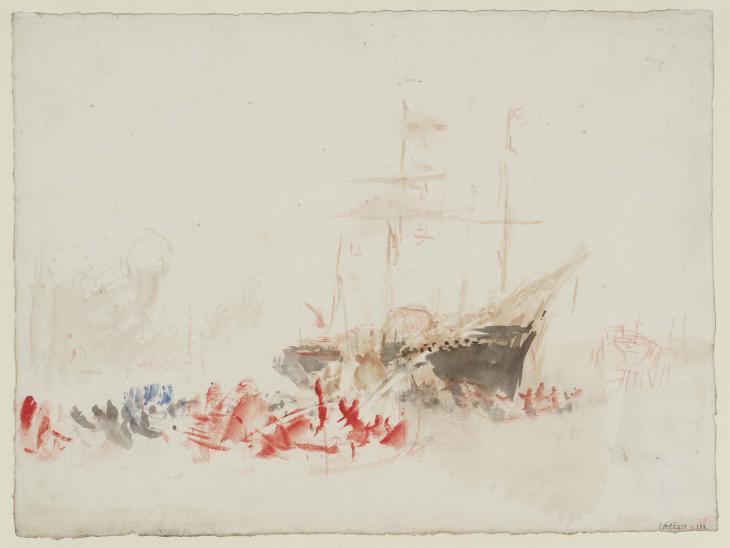Joseph Mallord William Turner The Arrival of Louis-Philippe: The 'Gomer' in Portsmouth Harbour 1844
Joseph Mallord William Turner,
The Arrival of Louis-Philippe: The 'Gomer' in Portsmouth Harbour
1844
Joseph Mallord William Turner 1775–1851
The Arrival of Louis-Philippe: The ‘Gomer’ in Portsmouth Harbour 1844
D35981
Turner Bequest CCCLXIV 138
Turner Bequest CCCLXIV 138
Watercolour on white wove paper, 237 x 318 mm
Blind-stamped with Turner Bequest monogram towards bottom right
Inscribed by ?John Ruskin in blue ink ‘1607’ bottom right
Inscribed in red ink ‘138’ bottom right
Stamped in black ‘CCCLXIV – 138’ bottom right
Blind-stamped with Turner Bequest monogram towards bottom right
Inscribed by ?John Ruskin in blue ink ‘1607’ bottom right
Inscribed in red ink ‘138’ bottom right
Stamped in black ‘CCCLXIV – 138’ bottom right
Accepted by the nation as part of the Turner Bequest 1856
Exhibition history
1974
Turner 1775–1851, Royal Academy, London, November 1974–March 1975 (636, as ‘A Sailing Boat surrounded by Small Boats’, c.1845, reproduced).
1975
Turner 1775-1851: zhivopis', risunok, akvarel', Hermitage Museum, Leningrad, October–November 1975, Pushkin Museum, Moscow, December 1975–January 1976 (87, reproduced).
1987
Turner and the Channel: Themes and Variations c.1845, Tate Gallery, London, October–December 1987 (44, as ‘Sailing Ship surrounded by small Boats’, c.1845).
1993
Turner: The Final Years: Watercolours 1840–1851, Tate Gallery, February–May 1993 (39, as ‘The Arrival of Louis-Philippe: the “Gomer”’, 1844, reproduced).
2002
Our Roaring Channels: Turner, Portsmouth and the Sea, Portsmouth City Art Gallery, June–August 2002 (no catalogue).
2015
Turner’s Wessex: Architecture and Ambition, Salisbury Museum, May–September 2015 (no number, as ‘The Arrival of Louis-Philippe: the Gomer’, 1844, reproduced in colour).
References
1830
A.J. Finberg, A Complete Inventory of the Drawings of the Turner Bequest, London 1909, vol.II, p.1185, CCCLXIV 138, as ‘Shipping’, after c.1830.
1845
Andrew Wilton in Martin Butlin, Wilton and John Gage, Turner 1775–1851, exhibition catalogue, Royal Academy, London 1974, reproduced p.171, p.172 no.636, as ‘A Sailing Ship surrounded by Small Boats’, c.1845.
1975
Graham Reynolds, Turner 1775-1851: zhivopis', risunok, akvarel', exhibition catalogue, Hermitage Museum, Leningrad 1975, p.[49] no.87, reproduced p.[73].
1845
David Blayney Brown, Turner and the Channel: Themes and Variations c.1845, exhibition catalogue, Tate Gallery, London 1987, pp.20, 24 no.44, as ‘Sailing Ship surrounded by small Boats’, c.1845.
1993
Robert Upstone, Turner: The Final Years: Watercolours 1840–1851, exhibition catalogue, Tate Gallery, London 1993, pp.52–3 no.39, as ‘The Arrival of Louis-Philippe: the “Gomer”’, 1844, reproduced.
2012
James Hamilton, ‘“The time must come”: Turner and Royalty’, Turner Society News, no.118, Autumn 2012, p.16 fig.8 (colour).
2013
Ian Warrell, ‘“I saw Louis Philippe land at Portsmouth”: Fixing Turner’s Presence at the Arrival of the King of the French, 8 October 1844’, Turner Society News, no.120, Autumn 2013, p.9.
2014
Sam Smiles in David Blayney Brown, Amy Concannon and Smiles (eds.), Late Turner: Painting Set Free, exhibition catalogue, Tate Britain, London 2014, p.168.
2015
Ian Warrell, Turner’s Wessex: Architecture and Ambition, exhibition catalogue, Salisbury Museum 2015, pp.179, 202, as ‘The Arrival of Louis-Philippe: the Gomer’, 1844, fig.178 (colour).
Like the other works grouped here, this relates to the arrival of Louis-Philippe, King of the French, at Portsmouth Harbour on 8 October 1844, as discussed in the Introductions to this subsection and the overall section.1 This is the most pictorially developed of the watercolours in this subsection, and the key to identifying the subject and the sequence in general. Andrew Wilton initially described it as a ‘complex scene economically noted in red and black: the subject is probably some ceremonial occasion; or it may be connected with the series of whaling subjects on which Turner was engaged in 1845–6’2 (see below). David Blayney Brown noted that it shows ‘a vessel like a royal yacht’, connecting it potentially with Louis-Philippe’s arrival or Queen Victoria’s return visit in 1845.3
From contemporary sources, Robert Upstone was able to rule out the two-masted Victoria and Albert I used on the latter occasion and confirm the subject as the Gomer, the King’s large and distinctive hybrid sail-steamship.4 Compare in particular the detailed 1846 painting Débarquement de Louis-Philippe à Portsmouth, le 8 octobre 1844 by Eugène Isabey (1803–1886; Château de Versailles), and see Tate D35959 (Turner Bequest CCCLXIV 116), which appears to show the Gomer’s stern. Upstone described the ‘throng of small boats’ in the foreground, suggesting that the ‘lack of detail gives something of the feel of the blur of frenetic activity and celebration of the crowd’.5
As noted in the overall Introduction, James Hamilton has ingeniously suggested that two paintings with foregrounds filled with rather overloaded boats, ‘Hurrah! for the Whaler Erebus! Another Fish!’ (Tate N00546)6 and Whalers (Boiling Blubber) Entangled in Flaw Ice, Endeavouring to Extricate Themselves (Tate N00547),7 began as depictions of Louis-Philippe’s arrival. He has specifically linked the foreshortened ship on the left of Boiling Blubber with the present view of the Gomer.8
Verso:
Blank; stamped in black with Turner Bequest monogram over ‘CCCLXIV – 138’ towards bottom left.
Matthew Imms
September 2016
How to cite
Matthew Imms, ‘The Arrival of Louis-Philippe: The ‘Gomer’ in Portsmouth Harbour 1844 by Joseph Mallord William Turner’, catalogue entry, September 2016, in David Blayney Brown (ed.), J.M.W. Turner: Sketchbooks, Drawings and Watercolours, Tate Research Publication, March 2017, https://www

